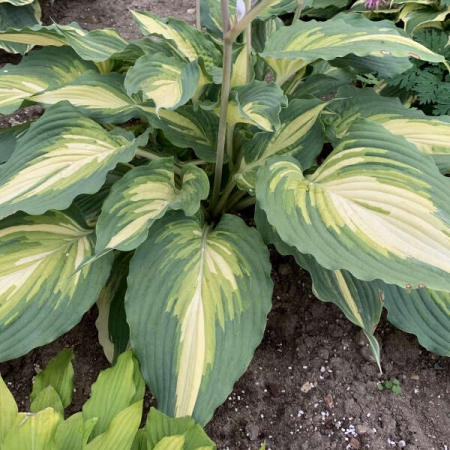Hosta (Hosta)
×
Color Name: Love Story
This Hosta will be a part of your garden "love story." Long heart-shaped leaves have medium green margins with chartreuse jetting that bleeds into creamy white centers. The medio-variegation extends from leaf tip to the petiole, flaring at the base of the leaf. A gentle piecrust wave edges each leaf. Tall scapes hold large clusters of tubular white flowers in early summer, creating a Hosta that can be enjoyed for its foliage and flowers.
Hostas are exceedingly popular perennials in today's gardens due to their versatility in the landscape. Their subtle colors, tall flower scapes, and broad, coarse leaves fill a niche in garden designs that few other plants can achieve. Their large leaves provide excellent coverage for dying bulb foliage.
Growing Tips: Hostas grow best in moist, well-drained, highly organic soils with a pH between 5.5 and 7.5. Sandy loam is better than clay because it provides more aeration for the roots. High-filtered or dappled sunlight is necessary for clean, healthy growth. Morning sun is tolerable and will help to intensify the leaf colors, but hot afternoon sun is usually deadly to hostas. They are most at home in shady, woodland settings and often work well as specimen or edging plants.
Especially in northern zones, hostas should be mulched with a layer of finely shredded organic material to prevent heaving in the winter. Mulch is beneficial because it retains moisture around the plant's roots, but it is also the ideal place for slugs to hide. Watch for holes in the center of the leaves. If they are present, so are slugs. Applying a slug bait in early spring when new shoots are beginning to emerge will help to reduce the slug population. After a few years when plants are firmly established, the mulch can be removed completely, which should eliminate the slug problem altogether. Also be sure to clean all hosta foliage out of the garden in early winter after the plants have gone dormant. By doing so, you will be ridding the area of the eggs of slugs and other leaf-eating insects.
Photo courtesy of Walters Garden, Inc.
This Hosta will be a part of your garden "love story." Long heart-shaped leaves have medium green margins with chartreuse jetting that bleeds into creamy white centers. The medio-variegation extends from leaf tip to the petiole, flaring at the base of the leaf. A gentle piecrust wave edges each leaf. Tall scapes hold large clusters of tubular white flowers in early summer, creating a Hosta that can be enjoyed for its foliage and flowers.
Hostas are exceedingly popular perennials in today's gardens due to their versatility in the landscape. Their subtle colors, tall flower scapes, and broad, coarse leaves fill a niche in garden designs that few other plants can achieve. Their large leaves provide excellent coverage for dying bulb foliage.
Growing Tips: Hostas grow best in moist, well-drained, highly organic soils with a pH between 5.5 and 7.5. Sandy loam is better than clay because it provides more aeration for the roots. High-filtered or dappled sunlight is necessary for clean, healthy growth. Morning sun is tolerable and will help to intensify the leaf colors, but hot afternoon sun is usually deadly to hostas. They are most at home in shady, woodland settings and often work well as specimen or edging plants.
Especially in northern zones, hostas should be mulched with a layer of finely shredded organic material to prevent heaving in the winter. Mulch is beneficial because it retains moisture around the plant's roots, but it is also the ideal place for slugs to hide. Watch for holes in the center of the leaves. If they are present, so are slugs. Applying a slug bait in early spring when new shoots are beginning to emerge will help to reduce the slug population. After a few years when plants are firmly established, the mulch can be removed completely, which should eliminate the slug problem altogether. Also be sure to clean all hosta foliage out of the garden in early winter after the plants have gone dormant. By doing so, you will be ridding the area of the eggs of slugs and other leaf-eating insects.
Photo courtesy of Walters Garden, Inc.
|
Flower Color: White Shades Foliage Color: Variegated Green/White Shades
Height: 14 to 16 Inches Spread: 36 to 42 Inches Hardy in Zone: 4, 5, 6 |
Blooms: Late Summer Mid-Summer
Foliage Season: All season |
Growth Rate |
Medium
|
Attributes |
Container Border Cut Flower or Foilage Drought Tolerant Easy to Grow Landscapes Mass Planting Specimen Plant
|






